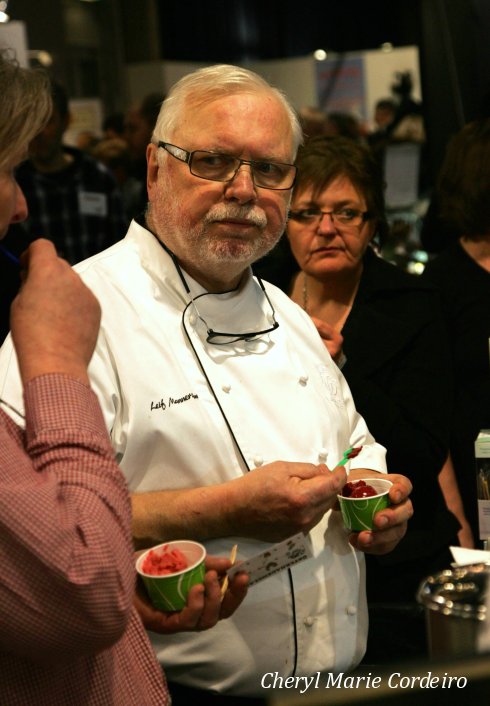
The Grand Old Man of Western Swedish Gastronomy and Guide Micheline star Chef Leif Mannerström gives the thumbs up of one of the new flavours at the Österhagens ice-cream stall. No surprise perhaps. Stig’s and Inger’s efforts are well known, and recognized by Diplomas of Execellence awarded by the Western Swedish Academy of Gastronomy in 2008 and by the Swedish Academy of Gastronomy in 2010.
Adding the last touches, ahead of opening

Early Friday morning the staff at the Swedish Coffee house Löfbergs Lila were adding the last touches to their stall. Besides coffee, they feature a vintage 1960 French delivery truck with forward opening “girl catching” doors, painted in their corporate colors and rebuilt into a coffee van. Together with the smell of freshly brewed coffee samples, nothing beats this as a crowd puller.
Photo © JE Nilsson for CMC 2011
Yesterday, Friday the 25th of February, 2011 – the forth installment of the food fair Passion för Mat 2011 at Eriksbergshallen in Gothenburg opened its gates for the expectant crowds.
This particular food fair is a crowd pleaser in that its exhibitors are overwhelmingly generous with giving out samples of most everything displayed to be sold.
I had arrived well ahead of opening hours this first day, since I had planned to help some at the booth of the Western Swedish Academy of Gastronomy friends organization. The steady paced group of exhibitors – bright, friendly and enthusiastic – are so passionate about what they do that it’s a joy to be there. Taking my time, I strolled around the expansive hall to say hello to friendly faces who like me, were adding a last few touches to their stalls.
One of the trends today in upscale dining is that the food comes with a story. The produce should be grown as close to the consumption as possible. Both in time and geography. The fish should ideally be alive when it goes into the pot and as one Chef puts it, if we push this just a little bit further, people will need to bite into the cow in the barnyard. So, people here know what they are selling. If they hadn’t baked, cooked or canned everything themselves, they at least knew those who did.
After grabbing a coffee from the remarkably attention grabbing purple vintage 1960 van at the Löfbergs Lila stand, I wandered on.
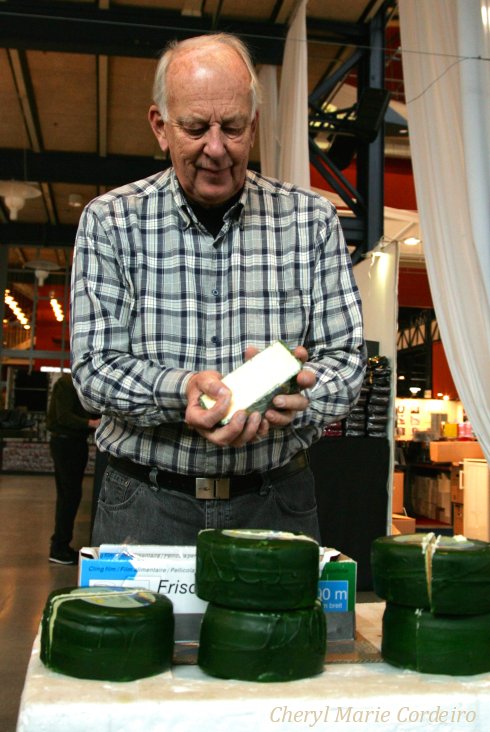
Taking his time to get it neat, Hans Tunhov the owner and manager of Birgittas Matbod, had come all the way from Öland to present marmalades, Elderflower and Champagne flavoured honey and pickled tomatoes. Right now he had some ninety cheeses from Ölands Ost to cut, wrap and display.
There were several open floor debates on current food trends during the day, one of which highlighted the fact that the average consumer’s lack of trust in their own senses, judging the quality of the food in supermarkets by the product’s expirty date meant that large quantities of perfectly good food were discarded because they could not be sold. Industry experts thus encouraged people to use their sense of sight, smell and taste when buying groceries in supermarkets to avoid wastage of food. Another track on food trends highlighted how homemade sausages with a high meat content was the new “sourdough”, where it is considered luxury and high status to be able to make your own sausages at home. Fact is though, that having the time to cook and prepare anything in your own kitchen today is true luxury.
Crispbreads with Heart in Mind
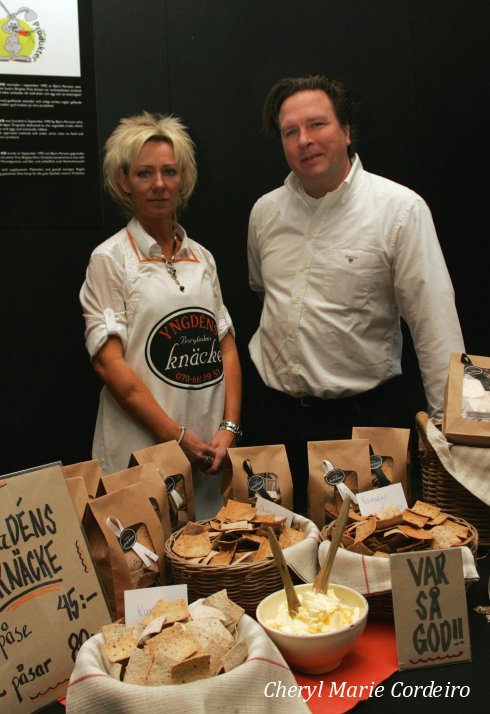
Gunilla and Joakim Yngdén of Yngdéns Knäcke.
The Yngdéns have baked their unique brand of thin crispbread since 1999, though Joakim Yngdén is the third generation in the industry. His family business began with his grandmother, Ebba Svensson’s Ebba’s Pastry Shop in 1938. We discussed where these new ultra thin crisps came in, in a meal, and Joakim explained that cheese shops promoted them as an alternative cracker and that some restaurants had taken to serve them in a bread basket with some butter ahead of meals. Indeed, they were surprisingly flavourful and tasted good with a sliver of sea salt butter on top each crisp.
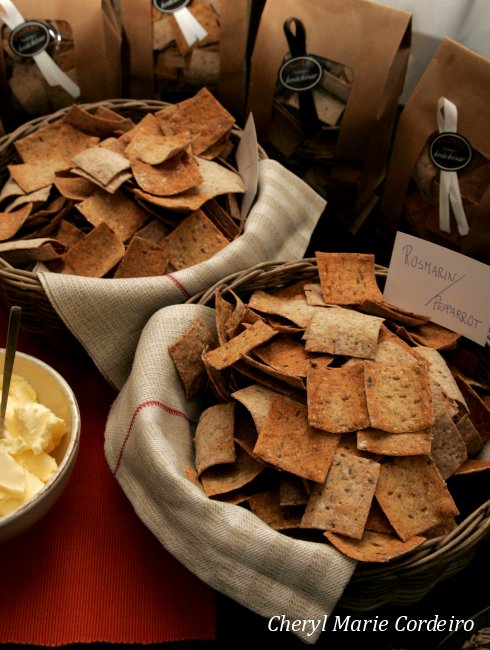
Served in linen lined woven baskets and those to be sold are packed in ribboned brown paper packages!
I couldn’t help but notice the packaging of these crispbreads that reminded me of 1930s Austria as seen in the movie The Sound of Music (1965), the years of which also happen to be contemporary to the pastry shop that had begun with Ebba Svensson in the late 1930s.
According to the Yngdén’s, the best crispbreads are crunchy with a raw juicy flavour of rye mixed with water, yeast, salt, linseed, sesame and sunflower seeds. And I couldn’t agree more because heart healthy foods don’t come better than these crispbreads packaged so beautifully in ribboned brown paper packages!
Sausages are the new Sourdough
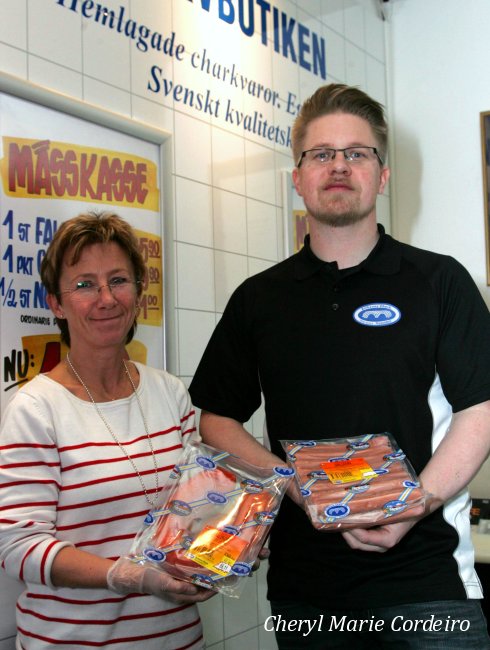
Eva Sjöstedt and Gustav Erikson of Erikson Chark.
Erikson Chark is a family owned company with the philosophy “Swedish made from Sweden”, that intends to support local produce in local industries. They have been making Swedish sausages from raw Swedish grown ingredients since 1923. Their Frankfurter made with only pork (92% meat content), salt and water and flavored with white pepper, nutmeg and cardamom took home the Gold Medal in the Swedish Culinary Championship in 2010. See also, this newsclip by GP for a brief interview with Gustav Erikson.
To crack each and every egg for good Ice-Cream
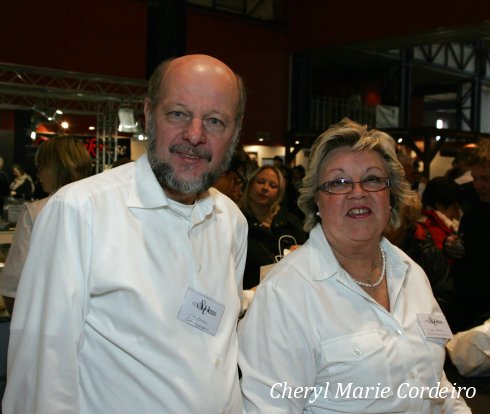
Stig Embro and Inger Hersby who make their own ice-cream in Hjo at Österhagenglass.
Österhagenglass from Hjo, is one more of those remarkable food companies where the owners are deeply passionate about what they do. We got to discuss if their ice-cream could get a wider recognition by export or franchise, Stig Embro took his time to explain that it wasn’t really that easy. What kept the company and their ice-creams exclusive was that they did their best to grow and select every single bit of ingredients that went into their ice-creams themselves.
The blackcurrant ice-cream for example, was made using berries from their own 400 bushes which Stig handpicked when the berries were at their very best, ripened in the summer sun. These were the only berries that went into their blackcurrant ice-cream. It was the same procedure with the raspberries and the strawberries etc. Every morning, he cracked every single egg that went into the ice-creams, as a form of quality control. Of course they could buy eggs ready cracked but then with the lack of control, the quality might go down one notch too, so – no. Same with the lemons that were carefully selected going into the ice-cream with no artificial flavours. Only the best lemons would be bought in and then stored for ripening for up to three weeks. This time allows for the sourness in the unripe lemons ordinarily found in the market, to mature into full flavoured sweet lemons that you could almost squeeze and drink as is. Same with the vanilla. Just real vanilla pods would be used in their ice-creams. So, at the end of the day this ice-cream factory was pretty ok with things as they were. With any expansion they might lose control and the quality might go down and it would not be fun any more.
Just to prove his point, I got a small sample of the blackcurrant sorbet. I am not a particular fan of blackcurrant, but it was heavenly to taste! The sorbet contained any number of soft flavours and blackcurrant bouquet. I was instantly transported out to the warm late summer days when these berries had been picked. I could taste the warm sunshine!

Birgitta Rasmusson, author of cookbooks, food critic and industry celebrity. Through her heading of the ICA food corporation test kitchen over the years and numerous cook book authorships, nobody has influenced the current Swedish kitchen as much as she.
The Open Cooking School
To one end of Erikbergshallen is Köksskolan or the open to public cooking school that runs programs on the hour, covering various themes from how to cook Vietnamese and Italian to how to best cook fish, meat and vegetables. This year, they even had an omelette frying competition with judge and jury. Below are some industry experts who took part in the public lessons.
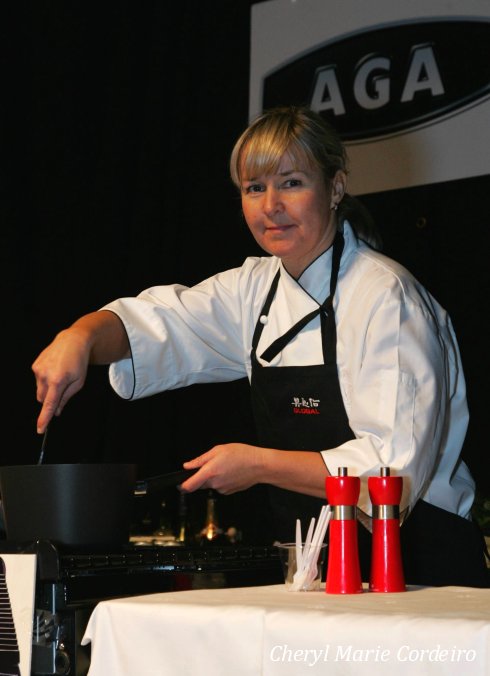
Western Academy member Katja Palmdahl lecturing about Vietnamese tastes in the fair’s open cooking school.
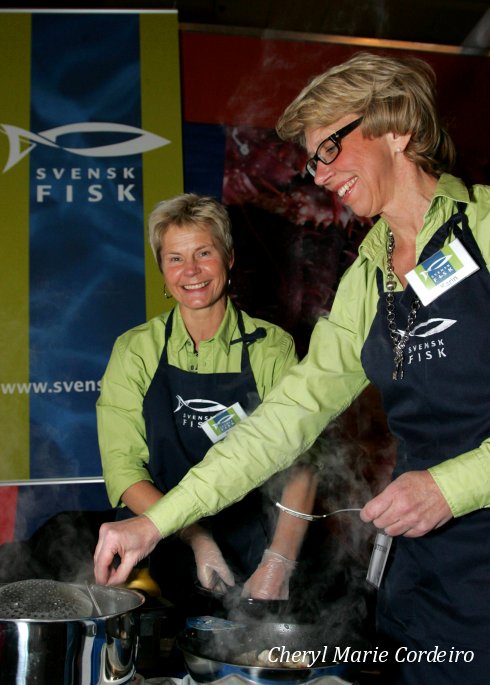
Ilona Miglavs (left) of Svensk Fisk, prize winner from the Swedish Western Academy of Gastronomy 2011.
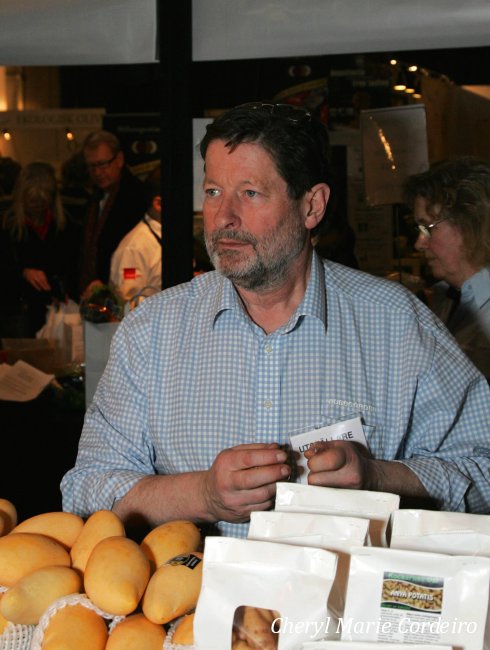
Dan Berntsson, a potato specialist who this year ran slightly tangent and flew in ripened, handpicked Mangoes from Thailand, specially for the tradefair. It was all that we could do to keep our hands off those mangoes!
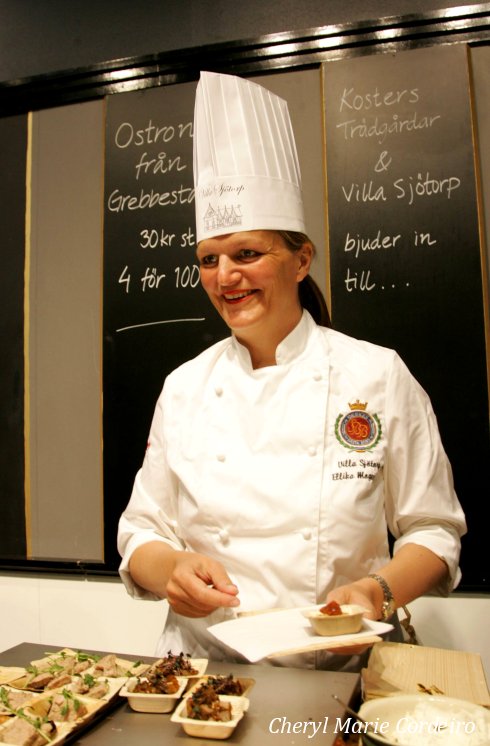
Ellika Mogenfelt of Villa Sjötorp, participates at the open cooking school during the tradefair.
Klädesholmen with rustic narrative of pickled herring
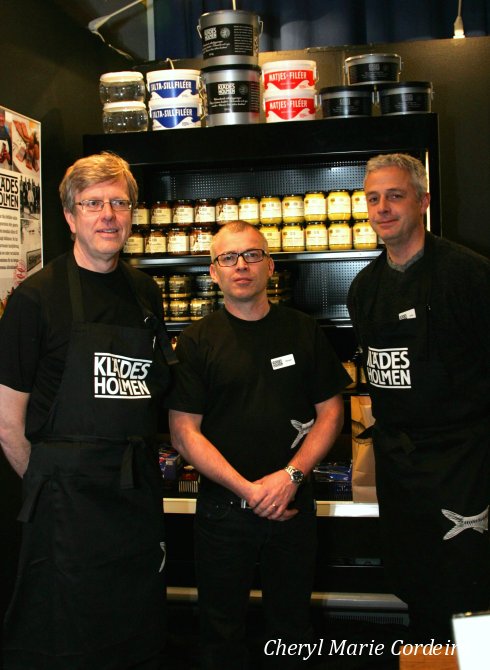
The guys behind Klädesholmen Sill – the art of making pickled herring in Sweden!
Kädesholmen was already a renowned fishing village along the Swedish west coast outside of Tjö in the sixteenth century. Its strong ties to the herring trade has been evident for centuries where generation after generation contributed to the development of its pickled herring delicacy. There are several families belonging to the area that today work collectively under the brand Klädesholmen, preserving the Swedish herring tradition. While the organization today is a modern one, it continues to build on their long tradition of craftsmanship, their unique feel of raw ingredients and the close customer relationships that only a few family businesses can offer.
Family owned – authentic Parmigiano Reggiano from Parma, Italy to Sweden!
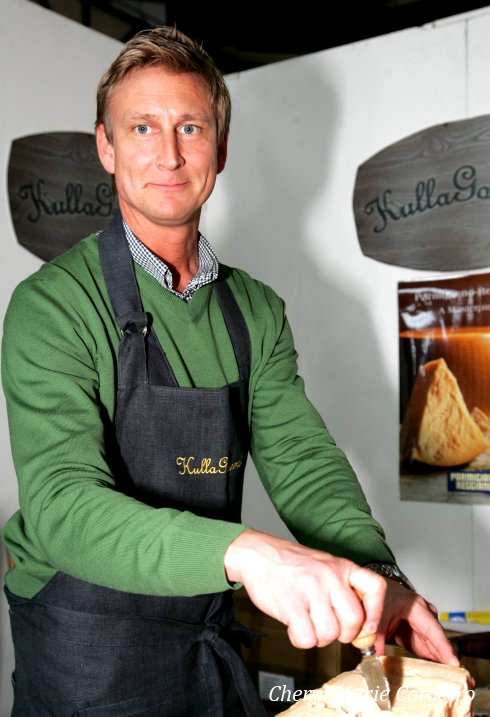
Gustaf Engholm of Kulla Gourmet.
Kulla Gourmet is a family business that brings into Sweden, an award winning Parmigiano Reggiano cheese from Parma, Italy. At the stall is Gustaf Engholm, whose sister Charlotte is married to an Italian from Parma. Charlotte and her husband have a farm on which they keep 80 alpine cows that supply milk to make these cheeses, so that what you found here were authentic Parmigiano Reggiano, from scratch to maturity!
Eggs finally explained
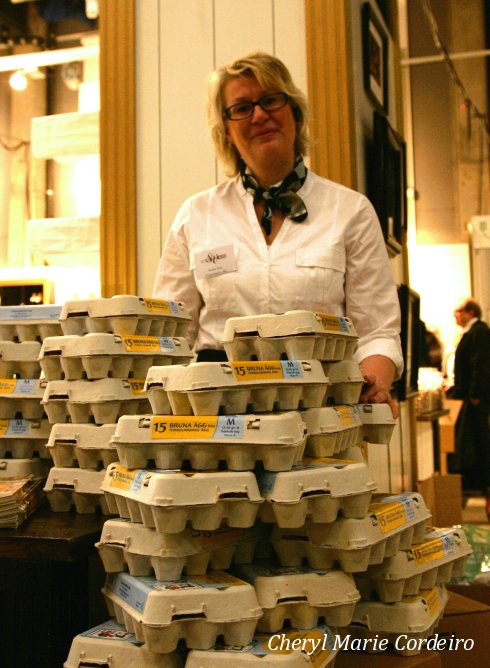
Madlen Dal with econological eggs from free range hens in Sweden.
I also met with Madlen Dal, from the Torggummans Egg corporation, who farms some 70,000 brown and white ecological hens for eggs in conditions as close to nature that you can possible come. Their philosophy is to give the birds a quality of life and to treat them well.
Regarding eggs, since the problem had become acute for me while being appointed to organize a breakfast buffet for the whole office at work, I now took the opportunity to get an expert’s answer as to why some eggs stick to the shell when you try to peel them. Suggestions on various internet sources were contradicting at its best, varying between that they should be cooled off real fast – or not, they should be cooked with vinegar or with lots of salt. None of this mattered, Madlein Dal told, who is also professionally an eggs quality inspector. Quick cooling might help some but ultimately it’s the age of the eggs that decides if the egg will stick to the shell or not. If you are planning a buffet, she told, where you need to have the eggs come out looking real neat, you need to put aside the eggs well in advance. When they approach the expiry date, they will be easy to peel. Off the records, Madlein also told, that she for her work kept eggs refrigerated for up to three weeks after expiry date to just check they were ok, and that the eggs besides becoming easy to peel, were perfectly fine to use even after that period of time. However, to be on the safe side, they would not say so on the boxes.
Sivan’s Hard Cheese
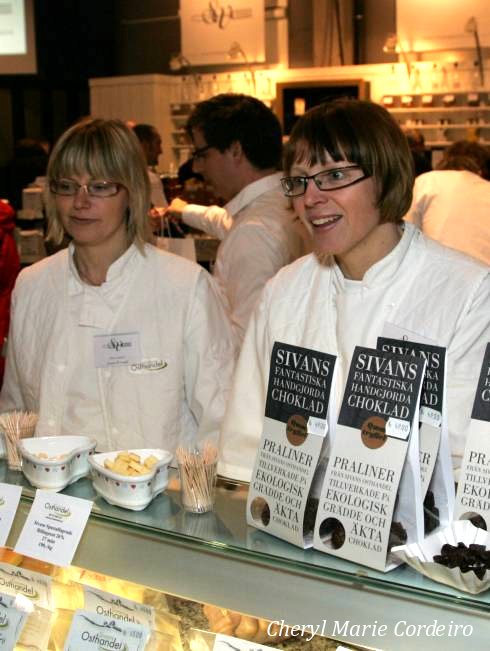
Sofia (right) expects to take over the family business, Sivans Osthandel, of making Swedish hard cheeses in the near future.
With Sivan’s Hard Cheese the profession of making hard cheeses had revolved around the women of the family since 1875. Pictured above is a bubbly Sofia in the midst of explaining the finer details of hard cheese making. She is the youngest daughter and are hoped and expected to eventually take over the traditional family business of making and maturing their own Swedish hard cheeses. The family’s efforts at making good cheeses were rewarded by a diploma from the Western Swedish Academy of Gastronomy already in 2000.
As Leonardo da Vinci had put it, “Where the spirit don’t work with the hand, there is no art.”, words that couldn’t ring more true in the food business. Food is best when freshly picked and cooked, and presented with the red hot passion from those who live the entire process, from growing to harvesting to watching the happy smiles of the customers.
The fair closes on Sunday the 27th so if you are around, go there and see for yourself.
One thought on “Passionate about food, a walk through Passion för Mat 2011, iGothenburg, Sweden”